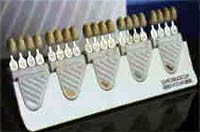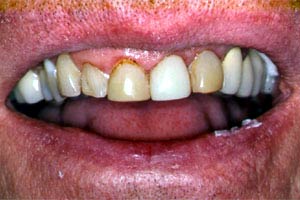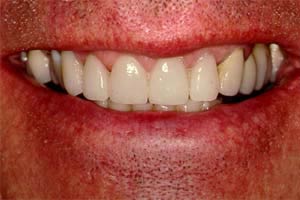| Crowns
A crown is placed for a number of reasons: To support a large filling
when there isn't enough tooth remaining; to attach a bridge; to
protect weak teeth from fracturing; and restore fractured teeth.
In order to determine which crown materials are suitable for an
individual,the following factors are considered:
a) Tooth location;
b) position of the gum tissue;
c) the function of the tooth;
d) the amount of the tooth that shows with the smile; and
e) the colour and shade of the tooth.
Crowns are prepared and placed in the following fashions: First,
the tooth is prepared by removing its outer portion to accommodate
the thickness of the crown. Then an impression is made to provide
an exact model of the tooth. The crown is made from this model.
It is then put in place and any necessary adjustments are made.
When it's position, appearance, feel, etc. are satisfactory, the
crown is then cemented into place. Once the procedure is complete,
the tooth will not only be stronger, it will also look great.
The teeth are "Shade Matched" to allow the crowns
to blend seamlessly into the patient's own dentition.
All Porcelain Crowns
For many years there has been increasing patient demands for improved
aesthetics in dental restorations. This demand has been especially
strong in the area of front teeth that require crowns (caps).
 |
 |
There have been many attempts to make an ALL porcelain crown. In
other words, a crown that would not have a metal substructure under
it. The reasons for wanting to eliminate the metal are primarily
to get rid of the dark line at the very edge of the crown and to
let more light pass through the porcelain (to look more lifelike).
There are other advantages to all porcelain as well - one such advantage
is that the dentist can keep the edge of the crown just at the gumline
rather than trying to "hide" it under the gumline. This
becomes important in the long term health of the gum tissues as
well as the appearance - even if there is slight receeding over
the course of years. In the past, there have been numerous attempts
to produce such an ideal crown. Unfortuately, there were always
problems - they easily fractured. The porcelain is not strong enough
to withstand the demands of chewing and grinding. One other problem
was the less than ideal fit of the porcelain crown to the prepared
tooth.
BUT...
the story has recently changed through a completely new technology.
The VITA In-Ceram System consists of an extremely accurate fitting,
highly stable aluminum oxide substructure that takes the place of
a metal substructure. Now we can obtain a colour that is not altered
by the metal underneath and that is also much more translucent (allows
light to pass through it) so that is looks natural. The BIG question
of course is how about its strength? Will it hold up? A study published
in 1994 showed that In-Ceram crowns fractured at the same (or greater)
pressure than metal-porcelain crowns did. This strength is three
times greater than that of other all-porcelain systems known to
date. One dental lab has now documented over 4,000 In-Ceram crowns
placed over a 4 year period, the failure rate is 0.01%!!
 |
 |
| All porcelain crowns with no metal
lines visible at the gum margin. |
|


